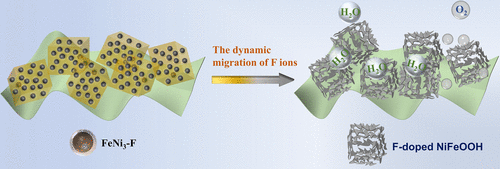当前位置:
X-MOL 学术
›
ACS Appl. Mater. Interfaces
›
论文详情
Our official English website, www.x-mol.net, welcomes your feedback! (Note: you will need to create a separate account there.)
Surface Fluorination Engineering of NiFe Prussian Blue Analogue Derivatives for Highly Efficient Oxygen Evolution Reaction
ACS Applied Materials & Interfaces ( IF 9.5 ) Pub Date : 2021-01-22 , DOI: 10.1021/acsami.0c20886 Fahao Ma 1 , Qian Wu 2 , Mu Liu 1 , Liren Zheng 1 , Fengxia Tong 1 , Zeyan Wang 1 , Peng Wang 1 , Yuanyuan Liu 1 , Hefeng Cheng 1 , Ying Dai 2 , Zhaoke Zheng 1 , Yuchen Fan 3 , Baibiao Huang 1
ACS Applied Materials & Interfaces ( IF 9.5 ) Pub Date : 2021-01-22 , DOI: 10.1021/acsami.0c20886 Fahao Ma 1 , Qian Wu 2 , Mu Liu 1 , Liren Zheng 1 , Fengxia Tong 1 , Zeyan Wang 1 , Peng Wang 1 , Yuanyuan Liu 1 , Hefeng Cheng 1 , Ying Dai 2 , Zhaoke Zheng 1 , Yuchen Fan 3 , Baibiao Huang 1
Affiliation

|
Surface engineering is of importance to reduce the reaction barrier of oxygen evolution reaction (OER). Herein, the NiFe Prussian blue analogue (NiFe-PBA)-F catalyst with a multilevel structure was obtained from NiFe-PBAs via a fluorination strategy, which presents an ultralow OER overpotential of 190 mV at 10 mA cm–2 in alkaline solution, with a small Tafel slope of 57 mV dec–1 and excellent stability. Interestingly, surface fluorination engineering could achieve a controllable removal of ligands of the cyan group, contributing to keep the framework structure of NiFe-PBAs. Particularly, NiFe-PBAs-F undergoes a dramatic reconstruction with the dynamic migration of F ions, which creates more active sites of F-doped NiFeOOH and affords more favorable adsorption of oxygen intermediates. Density functional theory calculations suggest that F doping increases the state density of Ni 3d orbital around the Fermi level, thus improving the conductivity of NiFeOOH. Furthermore, based on our experimental results, the lattice oxygen oxidation mechanism for NiFe-PBAs-F was proposed. Our work not only provides a new pathway to realize the controllable pyrolysis of NiFe-PBAs but also gives more insights into the reconstruction and the mechanism for the OER process.
中文翻译:

NiFe普鲁士蓝类似物衍生物的表面氟化工程用于高效放氧反应
表面工程对减少氧释放反应(OER)的反应势垒很重要。在此,通过氟化策略从NiFe-PBA获得了具有多级结构的NiFe普鲁士蓝类似物(NiFe-PBA)-F催化剂,该催化剂在碱性溶液中10 mA cm -2时具有190 mV的超低OER超电势。57 mV dec –1的小Tafel斜率和出色的稳定性。有趣的是,表面氟化工程可以实现可控制的氰基配体去除,从而有助于保持NiFe-PBA的骨架结构。特别是,随着Fe离子的动态迁移,NiFe-PBAs-F经历了戏剧性的重构,这产生了更多的F掺杂NiFeOOH活性位,并提供了对氧中间体的更有利吸附。密度泛函理论计算表明,F掺杂会增加费米能级附近的Ni 3d轨道的态密度,从而提高NiFeOOH的电导率。此外,根据我们的实验结果,提出了NiFe-PBAs-F的晶格氧氧化机理。
更新日期:2021-02-03
中文翻译:

NiFe普鲁士蓝类似物衍生物的表面氟化工程用于高效放氧反应
表面工程对减少氧释放反应(OER)的反应势垒很重要。在此,通过氟化策略从NiFe-PBA获得了具有多级结构的NiFe普鲁士蓝类似物(NiFe-PBA)-F催化剂,该催化剂在碱性溶液中10 mA cm -2时具有190 mV的超低OER超电势。57 mV dec –1的小Tafel斜率和出色的稳定性。有趣的是,表面氟化工程可以实现可控制的氰基配体去除,从而有助于保持NiFe-PBA的骨架结构。特别是,随着Fe离子的动态迁移,NiFe-PBAs-F经历了戏剧性的重构,这产生了更多的F掺杂NiFeOOH活性位,并提供了对氧中间体的更有利吸附。密度泛函理论计算表明,F掺杂会增加费米能级附近的Ni 3d轨道的态密度,从而提高NiFeOOH的电导率。此外,根据我们的实验结果,提出了NiFe-PBAs-F的晶格氧氧化机理。



























 京公网安备 11010802027423号
京公网安备 11010802027423号